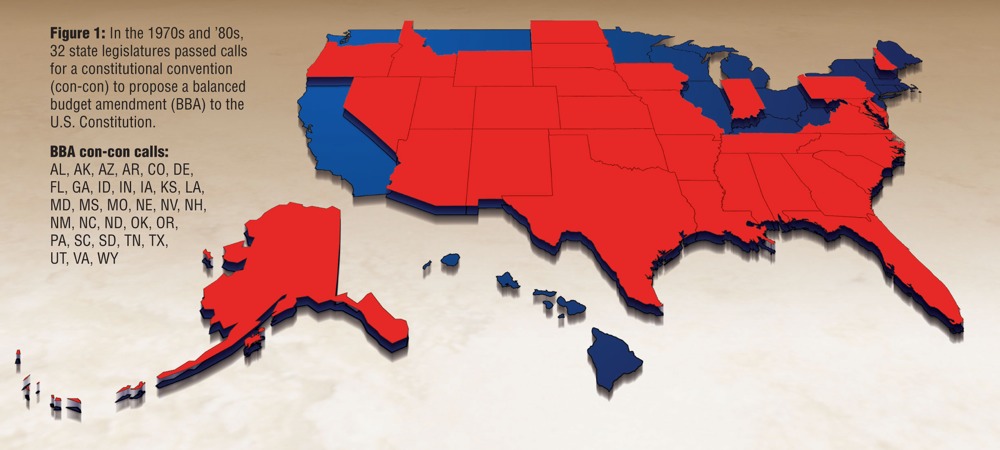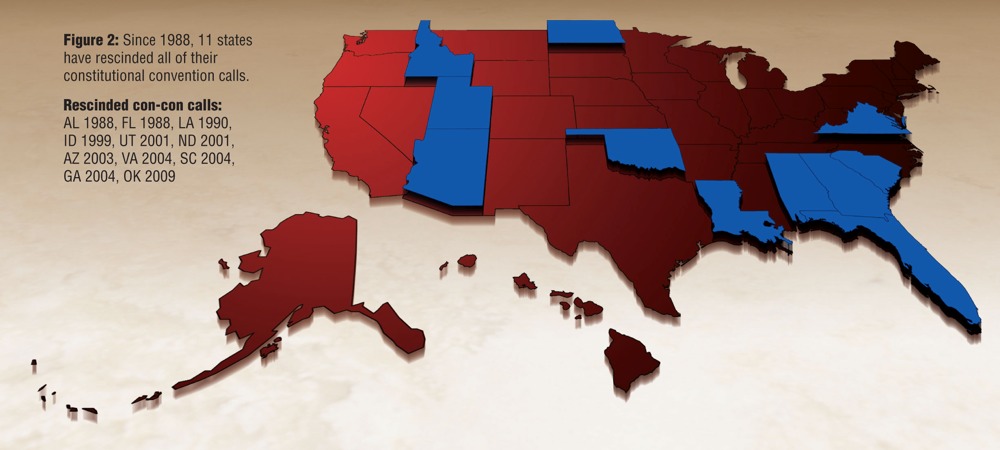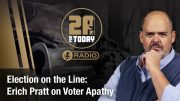This problem is not new, of course, but many Americans are becoming much more concerned about the effects that distant policymakers, politicians, and bankers are having on their lives and livelihoods, and they are becoming involved in political action for the first time.Perhaps the most visible manifestation of this great awakening to date would be the nationwide “Tea Party” events of April 15, when a million Americans rallied against big government and (in many cases) against the Fed, many of them for the first time.
But what, specifically, should be done to restore good government? Also, what strategy should be employed to get it done? Can Congress be persuaded to pass legislation restoring good government? Should Congress be encouraged to submit one or more constitutional amendments to the states for ratification? And if Congress does not appear willing to do what needs to be done, should the country hold its first constitutional convention (con-con) since the convention of 1787 that drafted the Constitution?
To those not familiar with the con-con movement, the latter question may sound fantastic. Yet 32 state legislatures (just two short of what was needed) called for a con-con to draft a balanced budget amendment during the 1970s and early ’80s. And now, Georgetown University law professor Randy Barnett and Tea Party leader Michael Patrick Leahy are calling for a constitutional convention. They claim that a con-con is needed to get the federal government back under control. Yet if such a convention would be called, there would be no way of controlling what it might or might not do — from proposing the specific amendments sought by Barnett to drafting an entirely new constitution.
What’s Wrong With a Con-Con
Although attempting to get the federal government back under control by amending the Constitution is very appealing to many conservatives and constitutionalists, it does not address the primary problem. The primary problem is that the three branches of the federal government do not adhere to the Constitution as originally intended by the Founders. Surprisingly, this indifference to the Constitution began with some of the decisions of Chief Justice John Marshall nearly 200 years ago. Over the years this indifference has grown slowly, but with the advent of the Obama presidential administration combined with a Democratic majority in both houses of Congress, we’re now witnessing almost daily naked displays of raw, unconstitutional usurpations of power by the federal government with regard to states, businesses, and individuals.
In this environment, simply amending the Constitution would not be sufficient to get the government back under control. However, there are numerous individuals and groups that still advocate constitutional amendments as the solution.
To understand the downsides of a con-con more fully, we need to take a closer look at Article V of the Constitution, which states:
The Congress, whenever two thirds of both Houses shall deem it necessary, shall propose Amendments to this Constitution, or, on the Application of the Legislatures of two thirds of the several States, shall call a Convention for proposing Amendments, which, in either Case, shall be valid to all Intents and Purposes, as part of this Constitution, when ratified by the Legislatures of three fourths of the several States, or by Conventions in three fourths thereof, as the one or the other Mode of Ratification may be proposed by the Congress.
According to Article V there are only two ways that amendments can be proposed to the Constitution: (1) by a two-thirds vote of both houses of Congress; or (2) on the application of the legislatures of two-thirds of the several states, Congress shall call a convention for proposing Amendments (commonly referred to as a “constitutional convention” or “con-con”). The second method has never been used. After amendments are proposed by either method, they then must be ratified by three-fourths of the state legislatures, or by three-fourths of special state conventions. According to Article V, Congress decides which ratification process will be used.
Although the con-con issue has rarely made it onto the radar of the national news over the years, a historic high-water mark for the con-con movement was reached in 1983, when Missouri became the 32nd state (out of the required 34) to call for a balanced budget constitutional convention (see the map in Figure 1). At about this time, members and allies of the John Birch Society began educating state legislators in the remaining 18 states about the dangers of a con-con.

Since 1983, several other state legislatures have considered calling for a balanced budget con-con, and all of them have decided that convening a constitutional convention is a bad idea. Next, members and allies of the John Birch Society began working with state legislators in the states that already had one or more con-con calls on record to convince them to rescind (withdraw) all of their previous con-con calls. So far 11 states have voted to rescind all of their previous calls (see Figure 2). The most recent example is Oklahoma. On May 12, Governor Brad Henry signed SJR 11, “A Joint Resolution rescinding applications by the Legislature to the United States Congress to call a constitutional convention.” This followed passage of SJR 11 by the nearly unanimous votes of 41-2 in the Senate and 90-6 in the House.
If you live in a state with one or more unrescinded con-con calls and you would like to work with your state legislators to rescind them, click here for a “Model Con-Con State Rescission Resolution,” which you can provide to them to introduce a rescission resolution in your state legislature.

In a nutshell, the argument against calling for a constitutional convention is that once convened, such a convention would be free to consider and propose whatever amendments to the Constitution that it deemed beneficial. Which is to say that such a convention could become a “runaway convention” in much the same way that the Constitutional Convention that produced our current U.S. Constitution was a runaway convention that disregarded the guidelines under which it was convened. While most Americans are very thankful for the Constitution produced by our original Constitutional Convention in 1787, most Americans and certainly most state legislators, when fully informed of the downsides involved, oppose the convening of a new constitutional convention in our day. (For a video presentation of the arguments against a con-con, see the 36-minute “Beware of Article V” video on YouTube.com or BirchTube on JBS.org.)
Warren Burger, former Chief Justice of the Supreme Court, argued along the same lines when he vigorously opposed convening a constitutional convention in a letter he wrote to Phyllis Schlafley of Eagle Forum on June 22, 1988:
I have also repeatedly given my opinion that there is no effective way to limit or muzzle the actions of a Constitutional Convention. The Convention could make its own rules and set its own agenda. Congress might try to limit the Convention to one amendment or to one issue, but there is no way to assure that the Convention would obey. After a Convention is convened, it will be too late to stop the Convention if we don’t like its agenda. The meeting in 1787 ignored the limit placed by the Confederation Congress “for the sole and express purpose.”
While it would be perfectly constitutional to convene an Article V constitutional convention, it would not be prudent. Given the present-day general lack of knowledge of both the Constitution and the original intent of our Founders, along with the inordinate influence over our political processes by very biased elites, the chances that a modern-day constitutional convention and subsequent ratification process could change our Constitution for the worse are too great to risk calling for such a convention.
We even have a warning directly from James Madison, the “Father of the Constitution,” concerning the inadvisability of calling for a constitutional convention. When the states of New York and Virginia formally petitioned Congress in 1788 to call a constitutional convention to propose amendments to the Constitution, which had only been completed the year before, Madison wrote a letter in which he emphatically warned against convening such a convention:
If a General Convention were to take place for the avowed and sole purpose of revising the Constitution, it would naturally consider itself as having a greater latitude than the Congress…. It would consequently give greater agitation to the public mind; an election into it would be courted by the most violent partisans on both sides … [and] would no doubt contain individuals of insidious views, who, under the mask of seeking alterations popular in some parts … might have the dangerous opportunity of sapping the very foundations of the fabric…. Having witnessed the difficulties and dangers experienced by the first Convention, which assembled under every propitious circumstance, I should tremble for the result of a second, meeting in the present temper in America. [From a letter by James Madison to G.L. Turberville, November 2, 1788.]
Two hundred twenty years later, James Madison’s arguments against the calling of an Article V constitutional convention are still very convincing. Even though he had been directly involved in crafting the Constitution the previous year, he specifically advised against exercising the provision in Article V for calling a new constitutional convention because “individuals of insidious views” could use the pretense of pursuing popular amendments to mask their real intentions of radically revising the Constitution.
Constitutional Convention Advocates
On April 23 the Wall Street Journal published an opinion piece by Professor Randy Barnett entitled, “The Case for a Federalism Amendment: How the Tea Partiers can make Washington pay attention.” In this article, Barnett observed that the 10th Amendment “sovereignty resolutions,” which petition Congress to respect the states’ rights protections of the Constitution, under consideration by over half of the states this year, are not likely to have the slightest impact on the federal courts. From this reasonable observation, Barnett proceeded to assert that “state legislatures have a real power under the Constitution by which to resist the growth of federal power: They can petition Congress for a convention to propose amendments to the Constitution.”
Barnett then went on to admit, “An amendments convention is feared because its scope cannot be limited in advance.” However, at this point he advocated a dangerous course. He proposed that the “tea-party enthusiasts” adopt his strategy of getting enough state legislatures to apply to Congress to call a constitutional convention, so that Congress will become scared of the prospect of a con-con and agree to endorse his amendment and present it to the states for ratification.
The problem with this strategy is that there’s no way to ensure that a con-con will not actually be convened in the process of this game of “playing chicken” with Congress, meaning the Constitution would be at stake.
On April 27 Barnett appeared as a guest on Michael Patrick Leahy’s show on PajamasTV (click here for the video of this show). During the four days between his WSJ article of April 23 and his PajamasTV appearance of April 27, Barnett changed his mind about his former strategy of scaring Congress into adopting his amendment with the threat of a con-con. Although he still acknowledged that there is widespread fear of a constitutional convention, and that he had had some worries about one, he was now convinced that the risks involved with a con-con were worth taking in order to get his new “Bill of Federalism” (a package of 10 proposed amendments that he had drafted over the previous few days) presented to the states for ratification. He puts a lot of stock in the requirement that three-fourths of the states are required to ratify whatever amendments might issue from a con-con. He believes this mechanism would surely prevent any truly bad amendment from being ratified.
Michael Patrick Leahy, co-founder of TCOT (Top Conservatives on Twitter) and through his participation in the Tax Day Tea Party website, an important national organizer of the Tax Day Tea Parties, supports Barnett’s con-con project to the hilt. By the time of the PajamasTV show on April 27, Barnett and Leahy were in complete agreement on the strategy of working for a con-con to get Barnett’s new list of 10 amendments submitted to the states for ratification.
In May Leahy put up a new website, “The Bill of Federalism”. Its homepage states: “The Bill of Federalism was drafted by Professor Randy Barnett of Georgetown University Law School and is supported by The Nationwide Tea Party Coalition.” Visitors to this website are urged to contact their local state legislators and request “that they introduce a bill in their legislative body to petition Congress to hold a Constitutional Convention for the purpose of passing all 10 amendments of The Bill of Federalism.”
Professor Barnett has also made several appearances on the Glenn Beck TV show in the last couple of months where he has promoted his con-con project with little or no contradiction from Beck. Surprisingly, constitutionalist Judge Andrew Napolitano has vigorously supported Barnett’s con-con project in at least three different appearances on Beck’s show since mid-April. (Click here for video of both Randy Barnett and Judge Napolitano promoting a constitutional convention on the Glenn Beck TV show of May 20, 2009.)
Happily, Beck has expressed his very strong opposition to a constitutional convention in a “Note from Glenn” at the bottom of an article on www.glennbeck.com, “How to Curtail the Federal Beast” by Judge Napolitano, dated May 15, 2009. Unfortunately, Beck has not made his anti con-con position known on his TV show during the past few months. Barnett and Napolitano have each made strong pitches for a con-con on Beck’s show several times since mid-April without even a word from Beck about the downsides of a con-con.
For example, Judge Napolitano was a guest on Beck’s TV show on May 25 (click here for video) and made still another plea for viewers to work toward a constitutional convention. Beck was on hand as host, but didn’t contradict the judge’s promotion of a con-con. The bottom line is that viewers of the Glenn Beck Show and consequently many of the over 600,000 online members of Beck’s Constitution-oriented 9/12 Project have been exposed to very powerful endorsements of the desirability of a con-con and have thus been prepared to serve in a mass movement right along with their Tea Party counterparts to bring about a very risky constitutional convention. Some good news, however, we have received word from a related 9/12 project group of 17,000 that is emphatically opposed to a con-con.
Hopefully, the many Americans who have already learned in-depth about the dangers of convening a constitutional convention will educate the organizers and participants in the Tea Party groups and the 9/12 Project about the downsides of a con-con before they can be organized into pressuring state legislators on a massive scale.
Yet another pro con-con website has appeared in recent weeks, the Constitution Restoration Initiative (CRI), which purports to have been established by citizens “yearning for freedom from the Federal government’s overreach.” Similar to Leahy’s website, the CRI has “a specific plan and strategy for the People to amend the Constitution by means of a Constitutional Convention.”
If you would like to contact your state legislators and warn them to oppose any calls for a constitutional convention, click here to send a pre-written, editable email message to this effect.
How to Safely Restore Good Government
In 1820, Thomas Jefferson gave us a safer and more effective prescription for correcting abuses of constitutional power:
I know no safe depository of the ultimate powers of the society but the people themselves; and if we think them not enlightened enough to exercise their control with a wholesome discretion, the remedy is not to take it from them, but to inform their discretion by education. This is the true corrective of abuses of constitutional power.
There is no easy way for getting the government back under control; however, as Jefferson sagely advised in 1820, the key is the creation of an informed electorate. Based on what we’ve already seen this year, we can hope to see the continued growth of a massive grass-roots movement among “the people themselves,” accompanied by appropriate Constitution-based educational initiatives, that would begin the process of forcing Congress and the presidential administration to adhere to the Constitution that we already have, then proceed to create the political atmosphere in which a majority of constitutionalists could be elected to Congress and state legislatures in the years to come.
Such a movement would consist of millions of freedom-loving, constitutionalists who have decided it’s now or never to rally around the Constitution we already have and take a stand for freedom!
Photo: AP Images



